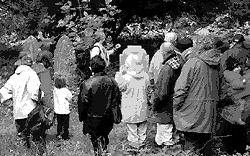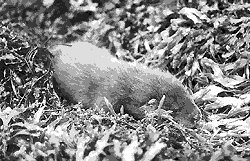MAMMAL GROUP
"Without you we are nothing... an organisation
can only reflect the sum of its parts... enthusiasm of individuals is
paramount." Clichés all, but gospel when considering the effectiveness
of a voluntary organisation. This has been an especially pertinent consideration
lately for the Cornwall Mammal Group as we capitalise on momentum already
established. The ink is still wet on the minutes of a meeting held to
get more people participating in the running of the group. The more people
involved then the higher our profile, the more events we can attend and
run, and the more mammal recording we can conduct, which results in positive
conservation gain for those species we seek to support. It was a meeting
charged with enthusiasm. There was no arm twisting and people have made
commitments of their time to help the group evolve - very heartening indeed.
We should see the fruits of these efforts in 2001.
Mammals can be extremely frustrating
to study as they are generally so elusive. Often one has to resort to
a bit of sleuthing. There is a craft and satisfaction in distilling out
the perpetrator of a muddy set of pawprints or the previous owner of a
snatch of hair left on a fence. The Trust, the Mammal Society and the
CMG run frequent training days - do get in touch for the next dates. If
you can't wait that long, then get yourself a good field guide. Local
libraries make a good starting point: try Mammal Detective by Rob Strachan
or the Collins Guide to Animal Tracks and Signs by Bang and Dahlstrom.
You may get hooked and part with that book token that you almost threw
out with the Christmas wrapping paper by mistake
Steve Townsend
OTTERS AND RIVERS PROJECT
December saw the publication of a report
into the status of the water vole in Cornwall. Disappointingly, no positive
signs of water voles were recorded, despite visiting over 150 sites and
mapping many kilometres of likely habitat. Funding from Viridor Waste
Management and South West Water (through the Pennon Water Champions fund),
English Nature and the Environment Agency enabled intensive surveying
to take place from June through to October. This is when water voles are
most active and leave handy field signs - droppings, latrines and feeding
remains - as well as their less ephemeral burrows. The survey looked at
sites most likely to yield a surviving water vole colony - based on historical
records, reports from members of the public and areas of good habitat.
Appeals for sightings in the spring resulted in an excellent public response.
Concern over water vole populations
was first expressed after two national surveys in 1989 and 1998. These
showed that populations had
crashed by 90 per cent nationally since
1900. Journals published by Cornish naturalists in the 1800s passed off
the water vole (or water rat as it is often known) as common, a view perpetuated
into the 1970s. We cannot say that the water vole is extinct in Cornwall
as there are many more sites which might be surveyed. However, it does
prove that the species is certainly very rare and, if still existent,
then surviving in very isolated populations which must by their very nature
be highly vulnerable. But don't despair yet - we are compiling likely
sites for surveying in 2001, so do get in touch if you can help or would
like further information.
Steve Townsend
LIVING CHURCHYARDS
Wildlife amongst the tombstones
A jackdaw flies in and out of the tower,
a thrush can be heard sounding its rattling alarm amongst the yews and
a little flash of colour can be spotted as blue tits fly from holly to
yew. The wildlife at Bodmin's Berry Tower is being surveyed by Grace Cory,
who has recently completed an HND in Heritage, Environment and Economic
Development, including this site in the Living Churchyards project. The
site itself, containing the remnants of a 15th century guild chapel of
the Holy Rood, is of rare archaeological value. The cemetery is owned
by Bodmin Town Council and the aim of the project is to devise a management
plan so that the area can be maintained with sympathy for wildlife and
be equally tidy and attractive to visitors and mourners.
A diversity of wildlife has been identified
with the help of various experts. Despite the weather, about 40 local
people joined a successful church search day which was held in the early
summer, led by plant experts Mary and Tony Atkinson and geologist John
Macadam. In the evening, Adrian Spalding joined the gathering and identified
20 species of moths, and Sally Caudle fascinated everyone with her bat
detector.
Before the start of this project many
local people did not know what lay behind the walls of Berry Tower. Today,
thanks to the efforts of our experts, the interest of the local press
and a library display of photographs, the community of Bodmin, ranging
in ages from two to 72, is giving the project its support.
Grace Cory
Please look out for summer events
in Hessenford, Luxulyan and Lelant churchyards.

A project based on the Berry
Tower has motivated the community of Bodmin to take a new interest in
its wildlife.
Photo: Grace Cory

The last year's work by
the Otters and Rivers Project included Beth Simmons' study which revealed
that Cornish otters do like to be beside the seaside. Look carefully
at this otter pup in a bed of seaweed. Now wouldn't you like to join
our otter spotters? Call for details.
Photo: Ruth Adams